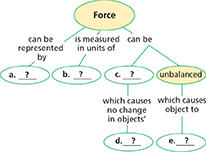CHAPTER 12 Study Guide
12.1 Forces
 Key Concepts
Key Concepts
A force can cause a resting object to move, or it can accelerate a moving object by changing the object's speed or direction.
When the forces on an object are balanced, there is no change in the object's motion. When an unbalanced force acts on an object, the object accelerates.
There are four main types of friction: static friction, sliding friction, rolling friction, and fluid friction.
Earth's gravity acts downward toward the center of Earth. Gravity causes objects to accelerate downward, whereas air resistance acts in the direction opposite to the motion and reduces acceleration.
The combination of initial forward velocity and downward vertical force of gravity cause a projectile to follow a curved path.
Vocabulary
force, p. 356; newton, p. 357; net force, p. 357; friction, p. 359; static friction, p. 359; sliding friction, p. 359; rolling friction, p. 360; fluid friction, p. 360; air resistance, p. 360; gravity, p. 361; terminal velocity, p. 361; projectile motion, p. 362
12.2 Newton's First and Second Laws of Motion
 Key Concepts
Key Concepts
According to Newton's first law of motion, the state of motion of an object does not change as long as the net force acting on the object is zero.
According to Newton's second law of motion, the acceleration of an object is equal to the net force acting on it divided by the object's mass.
Acceleration
Momentum = × Acceleration due to gravity
Mass is a measure of the inertia of an object;
Vocabulary
inertia, p. 364; mass, p. 365; weight, p. 368
12.3 Newton's Third Law of Motion and Momentum
 Key Concepts
Key Concepts
According to Newton's third law of motion, forces exist as equal and opposite force pairs.
Momentum = Mass × Velocity
An object has a large momentum if the product of its mass and velocity is large.
Momentum is conserved in a closed system.
Vocabulary
momentum, p. 374; law of conservation of momentum, p. 376
12.4 Universal Forces
 Key Concepts
Key Concepts
Electric and magnetic forces are the only forces that can both attract and repel.
The strong and weak nuclear forces hold the nucleus together.
Newton's law of universal gravitation states that every object in the universe attracts every other object.
Vocabulary
electromagnetic force, p. 378; strong nuclear force, p. 379; weak nuclear force, p. 380; gravitational force, p. 380; centripetal force, p. 381
Thinking Visually
Concept Map Use the information on forces from the chapter to complete the concept map below.





